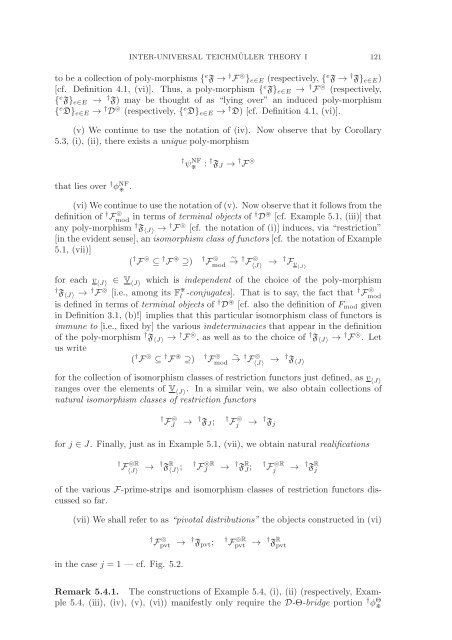Inter-universal Teichmuller Theory I: Construction of Hodge Theaters
Inter-universal Teichmuller Theory I: Construction of Hodge Theaters
Inter-universal Teichmuller Theory I: Construction of Hodge Theaters
Create successful ePaper yourself
Turn your PDF publications into a flip-book with our unique Google optimized e-Paper software.
INTER-UNIVERSAL TEICHMÜLLER THEORY I 121<br />
to be a collection <strong>of</strong> poly-morphisms { e F → † F ⊚ } e∈E (respectively, { e F → † F} e∈E )<br />
[cf. Definition 4.1, (vi)]. Thus, a poly-morphism { e F} e∈E → † F ⊚ (respectively,<br />
{ e F} e∈E → † F) may be thought <strong>of</strong> as “lying over” an induced poly-morphism<br />
{ e D} e∈E → † D ⊚ (respectively, { e D} e∈E → † D) [cf. Definition 4.1, (vi)].<br />
(v) We continue to use the notation <strong>of</strong> (iv). Now observe that by Corollary<br />
5.3, (i), (ii), there exists a unique poly-morphism<br />
that lies over † φ NF<br />
.<br />
† ψ NF<br />
<br />
: † F J → † F ⊚<br />
(vi) We continue to use the notation <strong>of</strong> (v). Now observe that it follows from the<br />
definition <strong>of</strong> † F ⊚ mod in terms <strong>of</strong> terminal objects <strong>of</strong> † D ⊛ [cf. Example 5.1, (iii)] that<br />
any poly-morphism † F 〈J〉 → † F ⊚ [cf. the notation <strong>of</strong> (i)] induces, via “restriction”<br />
[in the evident sense], an isomorphism class <strong>of</strong> functors [cf. the notation <strong>of</strong> Example<br />
5.1, (vii)]<br />
( † F ⊚ ⊆ † F ⊛ ⊇)<br />
† F ⊚ ∼<br />
mod<br />
→ † F ⊚ 〈J〉<br />
→ † F v〈J〉<br />
for each v 〈J〉 ∈ V 〈J〉 which is independent <strong>of</strong> the choice <strong>of</strong> the poly-morphism<br />
† F 〈J〉 → † F ⊚ [i.e., among its F l -conjugates]. That is to say, the fact that † F ⊚ mod<br />
is defined in terms <strong>of</strong> terminal objects <strong>of</strong> † D ⊛ [cf. also the definition <strong>of</strong> F mod given<br />
in Definition 3.1, (b)!] implies that this particular isomorphism class <strong>of</strong> functors is<br />
immune to [i.e., fixed by] the various indeterminacies that appear in the definition<br />
<strong>of</strong> the poly-morphism † F 〈J〉 → † F ⊚ ,aswellastothechoice<strong>of</strong> † F 〈J〉 → † F ⊚ . Let<br />
us write<br />
( † F ⊚ ⊆ † F ⊛ ⊇)<br />
† F ⊚ ∼<br />
mod<br />
→ † F ⊚ 〈J〉<br />
→ † F 〈J〉<br />
for the collection <strong>of</strong> isomorphism classes <strong>of</strong> restriction functors just defined, as v 〈J〉<br />
ranges over the elements <strong>of</strong> V 〈J〉 . In a similar vein, we also obtain collections <strong>of</strong><br />
natural isomorphism classes <strong>of</strong> restriction functors<br />
† F ⊚ J<br />
→ † F J ;<br />
† F ⊚ j → † F j<br />
for j ∈ J. Finally, just as in Example 5.1, (vii), we obtain natural realifications<br />
† F ⊚R<br />
〈J〉<br />
→ † F R 〈J〉 ; † F ⊚R<br />
J<br />
→ † F R J;<br />
† F ⊚R<br />
j<br />
→ † F R j<br />
<strong>of</strong> the various F-prime-strips and isomorphism classes <strong>of</strong> restriction functors discussed<br />
so far.<br />
(vii) We shall refer to as “pivotal distributions” the objects constructed in (vi)<br />
† F ⊚ pvt → † F pvt ;<br />
in the case j = 1 — cf. Fig. 5.2.<br />
† F ⊚R<br />
pvt<br />
→ † F R pvt<br />
Remark 5.4.1. The constructions <strong>of</strong> Example 5.4, (i), (ii) (respectively, Example<br />
5.4, (iii), (iv), (v), (vi)) manifestly only require the D-Θ-bridge portion † φ Θ
















